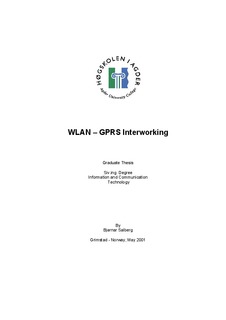| dc.description.abstract | During the last years it has been experienced a huge growth in Internet users. Nearly
each household in Norway got a computer attached to the Internet. The trend for
further growth seems to be within the concept of mobile Internet, which means that the
user can be attached anywhere at any time. The sales of mobile equipments like
personal digital assistants (PDAs) and laptops are currently experiencing a great
growth. This indicates a need for greater flexibility and mobility and gives therefore a
demand for mobile Internet.
The motive for this thesis was to investigate the opportunities to offer mobile Internet
on the basis of wireless technologies. The two largest telecom operators in Norway,
Netcom and Telenor Mobile, started offer GPRS early year 2001. GPRS is a
supplement to GSM, which offers packet switched data traffic. Wireless LAN (WLAN) is
another access technology that can be used for wireless access to the Internet. The
most used WLAN standard today are 802.11b. This standard is inexpensive and offers
relatively high data rata, up to 11Mbps.
GPRS offers a large coverage area and WLAN offers relatively high data rate. Building
a bridge between these two access technologies can have the potential of offering the
users both large coverage area through GPRS and high data rates through WLAN.
Adequate solutions for this needs to fulfill the requirement of not demanding the user to
actively change access technology. Neither should the user applications be affected of
the change.
Implementation of the bridging technology between WLAN and GPRS can be done at
different levels. This thesis discusses solutions based on integration at IP level and
integration with the GPRS network at a lower level.
The latter, also called the telecom-integrated solution, investigates the opportunities for
connecting a WLAN segment to the GPRS network without affecting existing network
nodes. The physical connection of the WLAN segment requires a bridge connected at
one of the interfaces specified for the GPRS user plane. Two different solutions are
described, one with the bridge connected at the Gn interface and one at the Gi
interface. The bridge must include both user plane and the signaling plane for the
GPRS network. The user equipment must be modified to handle location management
in GPRS, when connected to the WLAN segment.
The IP level solutions, described herein, are based on mobile IPv4 with home agent
and foreign agents. The main difference between these solutions is the location of
home agent and foreign agents. The home agent can be located at a corporate
network, an ISP or on the border of the GPRS network. Foreign agents can be located
at any network for the provisioning of connectivity to the mobile nodes.
The solutions based on physical connection of WLAN to the GPRS network are
complex and require great adjustments on the user equipment. The mobile IP solutions
require less of an effort to implement. The recommended implementation will be to use
the solution where the home agent is located at a corporate network or an ISP and
foreign agents at WLAN segments. When the user equipment is attached to GPRS or
a WLAN network without foreign agent a co-located care-of address will be used. If a
foreign agent is implemented into the GGSN node it will be preferred to take use a
care-of address belonging to the foreign agent. | en |
